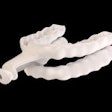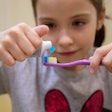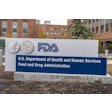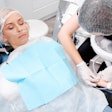
By now you may have gotten the question: "Have you put any bisphenol A in my mouth?" This plasticizer -- better known as BPA -- is a common ingredient in dental sealants and composite resins, and recent news reports have warned that it might cause cancer. So the question is cropping up more and more often in dental offices.
The best response so far is reassurance. Research so far doesn't show any risk from dental materials. "Up to now, I have not seen any problems from BPA in human in vivo data," said Michael Goldberg, D.D.S., Ph.D., an emeritus professor of dental surgery at Paris Descartes University who has researched toxins in composite resins. "But how the dentist deals with the patient -- that is a very real problem."
Why patients are concerned
BPA is estrogenic. Toxicologists worldwide have found that exposure to the chemical can promote breast, ovarian, and prostate cancer cell growth in animal models.
In April, Health Canada, the equivalent of the U.S. FDA, announced a plan to ban the importation and sale of baby bottles containing BPA. The FDA formed an agency-wide task force to review current evidence on the safety of BPA, in part due to a draft brief from the National Toxicology Program (NTP) of the National Institutes of Health
Based on animal studies, the NTP said it had "some concern" for neural and behavioral effects in fetuses, infants, and children at current human exposure levels to BPA. The group also had "some concern" over exposures in these same populations based on effects in prostate and mammary tissue and early puberty in females.
Democratic New York Sen. Charles Schumer and Hilary Clinton have introduced federal legislation to ban BPA in baby bottles and other containers destined for children. At least six states are considering their own bans on BPA in children's products.
What is this stuff, anyway?
BPA is a plasticizer used in many products, including rigid polycarbonate food storage containers such as water bottles, resin-based can liners, high-impact eye glasses, and medical devices. In dentistry, BPA is sometimes used in the synthesis of matrix monomers for fissure sealants and composite resins. It may also be present as in impurity in some resins (bisphenol A glycidyl dimethacrylate [bis-GMA]) or as a degradation product (bisphenol A dimethacrylate [bis-DMA] and bis-GMA).
The monomers in dental sealants and composites are polymerized in place, either by chemical curing or by photoactivation. But polymerization is seldom 100% complete. Unreacted monomers may leach out of the cured resin and react with the host.
BPA mimics some of the effects of estrogen, at least in animal studies. Cancers such as breast, ovarian, and prostate cancer, which have an overabundance of estrogen receptors, can be promoted by BPA. BPA has also been shown to affect the development of the prostate and mammary glands, as well as affect puberty in females.
Dental products look OK
Here's why patients should be less concerned about BPA safety in dental products:
Dental exposure to BPA is significantly lower than exposure from other sources such as hard plastic drinking cups or the resin-based liners in food and drink containers.
"All beer cans have more BPA in the liner than any dental product," said Yoav Finer, M.D., Ph.D., faculty of dentistry at the University of Toronto.
Clinical studies, including a 2000 report in the Journal of the American Dental Association (January 2000, Vol. 131:1, pp. 51-58), have found low levels of BPA in patient saliva immediately after sealant placement and composite resin restoration with systems containing BPA. But BPA in saliva disappears within three hours following the procedure. The same study found no detectable levels of BPA in patient serum from dental procedures.
And there are reasons to believe that the animal exposure studies, largely from mouse and rat models, may not apply to human beings. In humans, BPA is largely eliminated in first pass metabolism. BPA is not affected by first pass metabolism in mice or rats, so these rodents have higher serum levels and longer exposure times than in humans.
None of the regulatory moves to limit BPA exposure in North America involves dental or medical products. Health Canada concluded that BPA exposure from dental materials is extremely small and that no further regulation is needed. The FDA has not taken a position on BPA in dental products. The ADA said that concern is unwarranted at this time.
So the question isn't "Is BPA harmful?" but "How much BPA is harmful in humans?" There is no definitive answer. So what's a dentist to do?
It is clearly a bad idea to rip out existing composites, said Karl-Johan Söderholm, D.D.S., of the College of Dentistry at the University of Florida, Gainesville. That only increases the potential exposure to unreacted monomers. Replacing composites also adds exposure to byproducts from new systems about which even less is known than about BPA. And don't discount the hazards of an unnecessary dental visit.
"You are more likely to be in a traffic accident on the way to the dentist than have a problem from BPA in your composite," he said. "We don't have any indication that BPA is a clinical problem in the dental setting."
Practical steps
But patients want reassurance. And because there is a big difference between "no known problems" and "proven safe" in dental use, it makes sense to limit exposure.
The first choice: Dodge the BPA bullet. "A prudent approach for a dentist is not to use BPA-containing resin systems," Dr. Finer advised. "It is easy to choose systems that do not contain BPA."
Manufacturers are removing BPA from product formulations. Earlier this year, 3M said that 3M ESPE Concise Composite contains BPA but no other ESPE products have BPA added. GC America said that none of its products sold in North America contains BPA as an ingredient.
What about other manufacturers? The list of products that don't contain this chemical is constantly changing, researchers said.
"Because of competition, manufacturers are introducing new systems all the time," Dr. Söderholm cautioned. "Reference materials claim to show all of the ingredients, but they are out of date before they are published. You have to contact the manufacturers directly and often."
The next step is to remove any residual BPA. All restorations have an unreacted layer at the surface, Dr. Finer noted. A quick polish with pumice or another mild abrasive removes any unreacted materials. Problem solved.
For belt-and-suspenders types, Amir Azarpazhooh, D.D.S., M.Sc., of the University of Toronto has one more step: Have the patient gargle with tepid water for 30 seconds or wash the sealant surface for 30 seconds with an air-water syringe. Clinical studies, such as one reported in 2005 in the Journal of Materials Sciences: Materials in Medicine (April 2005, Vol. 16:4, pp. 297-300) found no detectible levels of BPA in patient saliva samples after a 20-second wash, so 30 seconds adds a 50% safety margin.



















